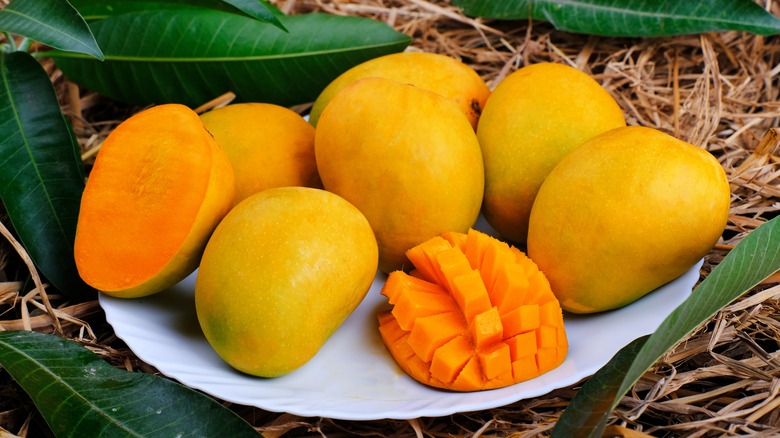How To Tell If A Mango Has Gone Bad
India is the ancestral home of mangos and produces close to half of the world's supply today, per World Atlas. The mango is not quite so ubiquitous in the U.S., where in 2021, it finished as only the 19th most commonly purchased fruit, via Fresh Produce; just behind clementines, and one spot ahead of plums. However, people living in both India and the U.S. are in accord that summer is the perfect season to enjoy this delicious tropical stone fruit.
Mangos are delightful to eat fresh or in fruit salads. They add a tropical flavor punch to a variety of salsas, salads, and smoothies. Mangos also make for a fantastic ice cream flavor. Additionally, they are a nutritional powerhouse and are considered a "super fruit," per Healthline. They are packed with antioxidants, alpha and beta carotene, as well as fiber; all of which offer an abundance of health benefits.
But like all produce, mangos have a not-so-super side; meaning that they're perishable and prone to spoilage. Here are a few of the warning signs that suggest your once fresh mango may have gone bad.
Signs your mangos should be thrown out
Commonsensical cues involve the look, feel, and smell of your mango in order to tell whether its healthy or needs to be discarded due to spoilage. Fresh mangos have a firm texture, while those that are starting to go bad may develop soft spots, notes Cooks Dream. Brown marks or mold on a mango or an unpleasant smell emanating from it are also signs that the fruit is either rotten or rapidly becoming so.
According to Does It Go Bad, consumers may likewise note a shriveling of the mango's skin as it ages, but will not see any signs in the color of the fruit. In most varieties, the color remains consistent regardless of its age or ripeness level. As for the shelf life of mangos, this varies according to storage conditions. If refrigerated, mangos should remain fresh for five to seven days, while those kept at room temperature generally only last for two to three days (per Does It Go Bad).
So, go ahead and hive this sweet treat a try but make sure to look for these cues before biting in.

